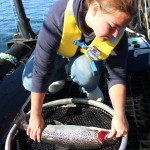
Jessica Johnson-Mackinnon
Microbiologist & Parasitologist
Institute for Marine and Antarctic Studies
From a very young age I was an observer and an explorer. My siblings and I would spend countless hours running around the wilderness of British Columbia getting into all sorts of adventures. I was quite privileged to be home-schooled by my Mom at the time. She is a marine biologist and geologist in her own right so our science classes were often supplemented with mini field studies and hands-on science experiments; our own personal Mrs. Frizzle. I was given my first microscope when I was 12 and from then on I was hooked. I would spend hours looking through my little microscope marvelling at this whole other world that hardly anyone ever bothered to think about. Through those years I developed a love of knowledge and learning that has stuck with me, not to mention a thirst for adventure that has taken me across the world!
It’s no surprise that by the time I’d entered University I knew I was in for a life of science though to be honest I was sure I was going to be a Doctor. I’ve always had a broad interest range however and the sky was the limit in terms of what could take my fancy. It wasn’t until a couple chance third year classes where I was introduced to and ultimately fell in love with microscopic parasites.
At the moment, the work I do focuses on a group of amoebae called Neoparamoeba perurans, who choose when (or if) they want to invade a host. N. perurans is responsible for amoebic gill disease, the most prevalent disease facing farmed Atlantic salmon in Tasmania. The amoebae attach to the gills of the salmon, making it hard for the salmon to breathe. It causes excess mucus production and death. I want to know how the amoebae are doing this. In order to answer that question I will be doing mass protein analysis and characterization along with directed sequencing to try and pinpoint the weapons (proteins) the amoebae have and how they use them. This will hopefully allow us to find possible vaccine targets or prevention measures. From there who knows where science will take me next!
For more information: www.imas.utas.edu.au